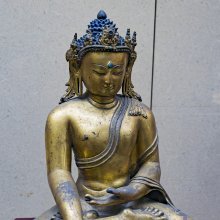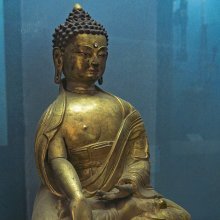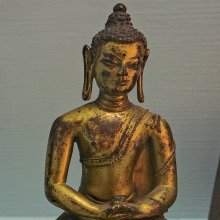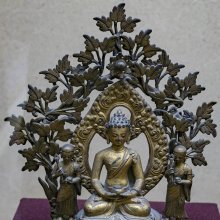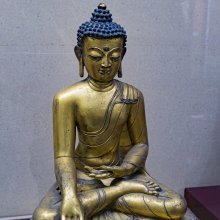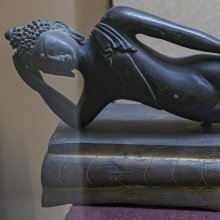Sakyamuni, Shakyamuni, Śākyamuni, Shakya-muni, Śākyamuṉi: 18 definitions
Introduction:
Sakyamuni means something in Buddhism, Pali, Hinduism, Sanskrit, Tamil. If you want to know the exact meaning, history, etymology or English translation of this term then check out the descriptions on this page. Add your comment or reference to a book if you want to contribute to this summary article.
The Sanskrit terms Śākyamuni and Śākyamuṉi can be transliterated into English as Sakyamuni or Shakyamuni, using the IAST transliteration scheme (?).
Images (photo gallery)
(+41 more images available)
In Buddhism
Theravada (major branch of Buddhism)
Source: Access to Insight: A Glossary of Pali and Buddhist Terms"Sage of the Sakyans"; an epithet for the Buddha.Source: Pali Kanon: Pali Proper NamesAn epithet of the Buddha. See Bu.xxvi.9; Mil. 115.
Theravāda is a major branch of Buddhism having the the Pali canon (tipitaka) as their canonical literature, which includes the vinaya-pitaka (monastic rules), the sutta-pitaka (Buddhist sermons) and the abhidhamma-pitaka (philosophy and psychology).
Mahayana (major branch of Buddhism)
Source: Wisdom Library: Maha Prajnaparamita SastraŚākyamuni (शाक्यमुनि) is the name of both the first as well as the present Buddha, according to the Vibhāṣā and the Kośa mentioned in the 2nd century Mahāprajñāpāramitāśāstra (chapter VI). Accordingly, “In one of his earlier lives, the present Buddha Śākyamuni was a potter (kumbhakāra) called Prabhāsa. At that time, there was a Buddha called Śākyamuni; his disciples were called Śāriputra, Maudalyāyana and Ānanda”.
Note: According to the Vibhāṣā and the Kośa, the ancient Śākyamuni was the first Buddha whom the present Śākyamuni venerated. At that time, the latter was a potter named Prabhāsa (cf. Kośavyākhyā). The Mahāvastu I, also is aware of a Buddha Śākyamuni who lived an infinite number of numberless kalpas ago, also from Kapilavastu, and who received the generosity of the present Śākyamuni, then a merchant (śreṣṭhin).
According to the Mahāvadānasūtra, Buddha Śākyamuni had an “assistant” (upasthāyaka) named Ānanda.—Each Buddha had his assistant (upasthāyaka), a monk specially attached to his person, entrusted with fanning him, carrying his robe and bowl for alms-round, introducing visitors. The Sanskrit Mahāvadānasūtra has drawn up a list of the assistants who served the last seven Buddhas: [...] Ānanda for Śākyamuni [...]

Mahayana (महायान, mahāyāna) is a major branch of Buddhism focusing on the path of a Bodhisattva (spiritual aspirants/ enlightened beings). Extant literature is vast and primarely composed in the Sanskrit language. There are many sūtras of which some of the earliest are the various Prajñāpāramitā sūtras.
General definition (in Buddhism)
Source: Wisdom Library: BuddhismŚākyamuni (शाक्यमुनि):—One of the Thirty-five buddhas of confession, according to the Trīskhandhadharmasūtra (‘Sutra of the Three Heaps’), which is a Mahāyāna sūtra. The sūtra describes the practice of purifying the transgressions of vows (especially the Bodhisattva-vows), by making prostrations to these Buddhas. In the Tibetan language (Wyl.), he is known as: sangs rgyas shAkya thub pa. His name means “the perfect buddha”.
Source: Wisdom Library: Dharma-samgrahaŚākyamuni (शाक्यमुनि) refers to the last of the “seven Buddhas” (saptatathāgata) as defined in the Dharma-saṃgraha (section 6). The Dharma-samgraha (Dharmasangraha) is an extensive glossary of Buddhist technical terms in Sanskrit (e.g., saptatathāgata and Śākyamuni). The work is attributed to Nagarguna who lived around the 2nd century A.D.
Source: Buddhist Door: GlossarySakayamuni in Sanskrit, Shakyamuni in Pali. The founder of Buddhism. He was born as the Prince of Sakyans, and was called Siddhartha Goutama. At the age of 35, he attained the supreme Enlightenment and became the Buddha and was the called Shakyamuni. The word means "capability and kindness".Source: The Art of Asia: Who is Who in HeavenShakyamuni (Chinese: Shih chia; Japanese: Shaka), the Historical Buddha, was born in the 6th century B.C. in Lumbini (present day Nepal), achieved enlightenment at the age of thirty five, and spent the remaining forty five years of his life preaching his doctrine of salvation to others.Source: Shambala Publications: GeneralShākyamuni Buddha, the historical Buddha, is not the first and only buddha. Already in the early Hīnayāna texts, six buddhas who preceded him in earlier epochs are mentioned: Vipashyin (Pali, Vipassi), Shikin (Sikhī), Vishvabhū (Vessabhū), Krakuchchanda (Kakusandha), Konagamana, and Kashyapa (Kassapa). The buddha who will follow Shākyamuni in a future age and renew the dharma is Maitreya. Beyond these, one finds indications in the literature of thirteen further buddhas, of which the most important is Dīpamkara, whose disciple Shākyamuni was in his previous existence as the ascetic Sumedha. The stories of these legendary buddhas are contained in the Buddhavamsa, a work from the Khuddakanikāya.
Languages of India and abroad
Pali-English dictionary
Source: BuddhaSasana: Concise Pali-English Dictionarysakyamuni : (m.) the noble sage of the Sakyans.

Pali is the language of the Tipiṭaka, which is the sacred canon of Theravāda Buddhism and contains much of the Buddha’s speech. Closeley related to Sanskrit, both languages are used interchangeably between religions.
Sanskrit dictionary
Source: DDSA: The practical Sanskrit-English dictionaryŚākyamuni (शाक्यमुनि).—epithets of Buddha.
Derivable forms: śākyamuniḥ (शाक्यमुनिः).
Śākyamuni is a Sanskrit compound consisting of the terms śākya and muni (मुनि). See also (synonyms): śākyasiṃha.
Source: Cologne Digital Sanskrit Dictionaries: Edgerton Buddhist Hybrid Sanskrit DictionaryŚākyamuni (शाक्यमुनि).—(= Pali Sak°; see also Śākyasiṃha), (1) epithet of the historic Buddha, passim; as 7th of the ‘seven Buddhas’, beginning with Vipaśyin, Dharmasaṃgraha 6; in Saddharmapuṇḍarīka 185.3 he is one of two Buddhas in the northeast, yet is located asyāṃ sahāyāṃ lokadhātau; Gaṇḍavyūha 419.20, see also Vairocana, who is identified with Ś. especially in Gaṇḍavyūha; (2) name of a former Buddha under whom ‘this’ (historic) Ś. made a praṇidhāna and received a prediction of Buddha- hood: Mahāvastu i.1.6; 47.13 ff.; in 57.8 thirty crores of Buddhas of this name were worshipped by, and predicted the Buddhahood of, (the historic) Ś. while he was cakravartin; in Lalitavistara 172.5 also a former B. of this name, to whom the historic Ś. made a gift; (3) name of (presumably) another past Buddha: Mahāvastu iii.238.10 ff.; (4) name of still another past Buddha, in the same list as (3), next in line to a Buddha named Yaśottara: Mahāvastu iii.240.4; 243.9, 10; 245.11; 247.7; 248.14; (in the same list, 240.10, the historic Ś. also names himself;) (5) name of a future Buddha, rebirth of a girl who made a praṇidhāna under the historic Ś. and for whom he predicted Buddhahood: Divyāvadāna 90.5, 28; (6) name of a future Buddha, rebirth of Vaḍika, similarly predicted by the historic Ś.: Avadāna-śataka i.35.3.
Source: Cologne Digital Sanskrit Dictionaries: Shabda-Sagara Sanskrit-English DictionaryŚākyamuni (शाक्यमुनि).—m.
(-niḥ) A name of Budd'Ha, the real or supposed founder of the Baudd'ha religion. E. śakya said to be the name of a family or tribe, originating with one of the race of Ikswaku, condemned to take up his abode in a forest of Saka trees, and muni a saint.
Source: Cologne Digital Sanskrit Dictionaries: Cappeller Sanskrit-English DictionaryŚākyamuni (शाक्यमुनि).—[masculine] the saint of the Śākyas, i.e. Buddha.
Source: Cologne Digital Sanskrit Dictionaries: Aufrecht Catalogus CatalogorumŚākyamuni (शाक्यमुनि) as mentioned in Aufrecht’s Catalogus Catalogorum:—is degraded into a common grammarian by Sāyaṇa in the Mādhavīyadhātuvṛtti.
Source: Cologne Digital Sanskrit Dictionaries: Monier-Williams Sanskrit-English DictionaryŚākyamuni (शाक्यमुनि):—[=śākya-muni] [from śākya] m. ‘Śākya sage’, Name of Gautama Buddha, [ib.; Kādambarī; Harṣacarita]; etc. (also -buddha).
Source: Cologne Digital Sanskrit Dictionaries: Yates Sanskrit-English DictionaryŚākyamuni (शाक्यमुनि):—[śākya-muni] (niḥ) 2. m. Idem.
[Sanskrit to German]
Sanskrit, also spelled संस्कृतम् (saṃskṛtam), is an ancient language of India commonly seen as the grandmother of the Indo-European language family (even English!). Closely allied with Prakrit and Pali, Sanskrit is more exhaustive in both grammar and terms and has the most extensive collection of literature in the world, greatly surpassing its sister-languages Greek and Latin.
Tamil dictionary
Source: DDSA: University of Madras: Tamil LexiconŚākyamuṉi (ஶாக்யமுனி) [śākya-muṉi] noun < Śākya-muni. The Buddha. See சாக்கியமுனி. [sakkiyamuni.]
Tamil is an ancient language of India from the Dravidian family spoken by roughly 250 million people mainly in southern India and Sri Lanka.
See also (Relevant definitions)
Partial matches: Shakya, Muni.
Full-text (+2440): Gotamanvaya, Gopesha, Dashabalakashyapa, Kulishasana, Gautama, Mahakashyapa, Maudgalyayana, Rahula, Dvivarnaratha, Uccadhvaja, Kapilavastu, Shakyasimha, Chandaka, Visheshagamin, Arada, Diptavirya, Gayakashyapa, Trimukha, Arka, Devadatta.
Relevant text
Search found 69 books and stories containing Sakyamuni, Shakyamuni, Śākyamuni, Shakya-muni, Śākya-muni, Sakya-muni, Śākyamuṉi, Śākya-muṉi, Shaagyamuni, Shagyamuni; (plurals include: Sakyamunis, Shakyamunis, Śākyamunis, munis, Śākyamuṉis, muṉis, Shaagyamunis, Shagyamunis). You can also click to the full overview containing English textual excerpts. Below are direct links for the most relevant articles:
Maha Prajnaparamita Sastra (by Gelongma Karma Migme Chödrön)
Appendix 5 - Appearance of the Buddha Prabhūtaratna < [Chapter XIII - The Buddha-fields]
Part 5 - Casting the mount sumerus far away < [Chapter XLIX - The Four Conditions]
Act 8: The Buddha smiles a fourth time: beings become aware of one another < [Chapter XIV - Emission of rays]
The gods of northern Buddhism (by Alice Getty)
Part I - Buddha < [Introduction]
Part IV - The Religious Community (sangha) < [Introduction]
A Blessed Pilgrimage (by Dr. Yutang Lin)
Chapter XXIV - Bodhisattva Gadgadasvara
Chapter XI - The Appearance of a Jeweled Stupa
The Gospel of Buddha (by Paul Carus)
A Record of Buddhistic Kingdoms (by Fa-Hien)
Related products
